Sonova USA ITEV13 Wireless Hearing Instrument User Manual User Guide Virto V 92x125 GB V1 00 029 0365 02
Phonak Inc Wireless Hearing Instrument User Guide Virto V 92x125 GB V1 00 029 0365 02
User Guide Virto V English
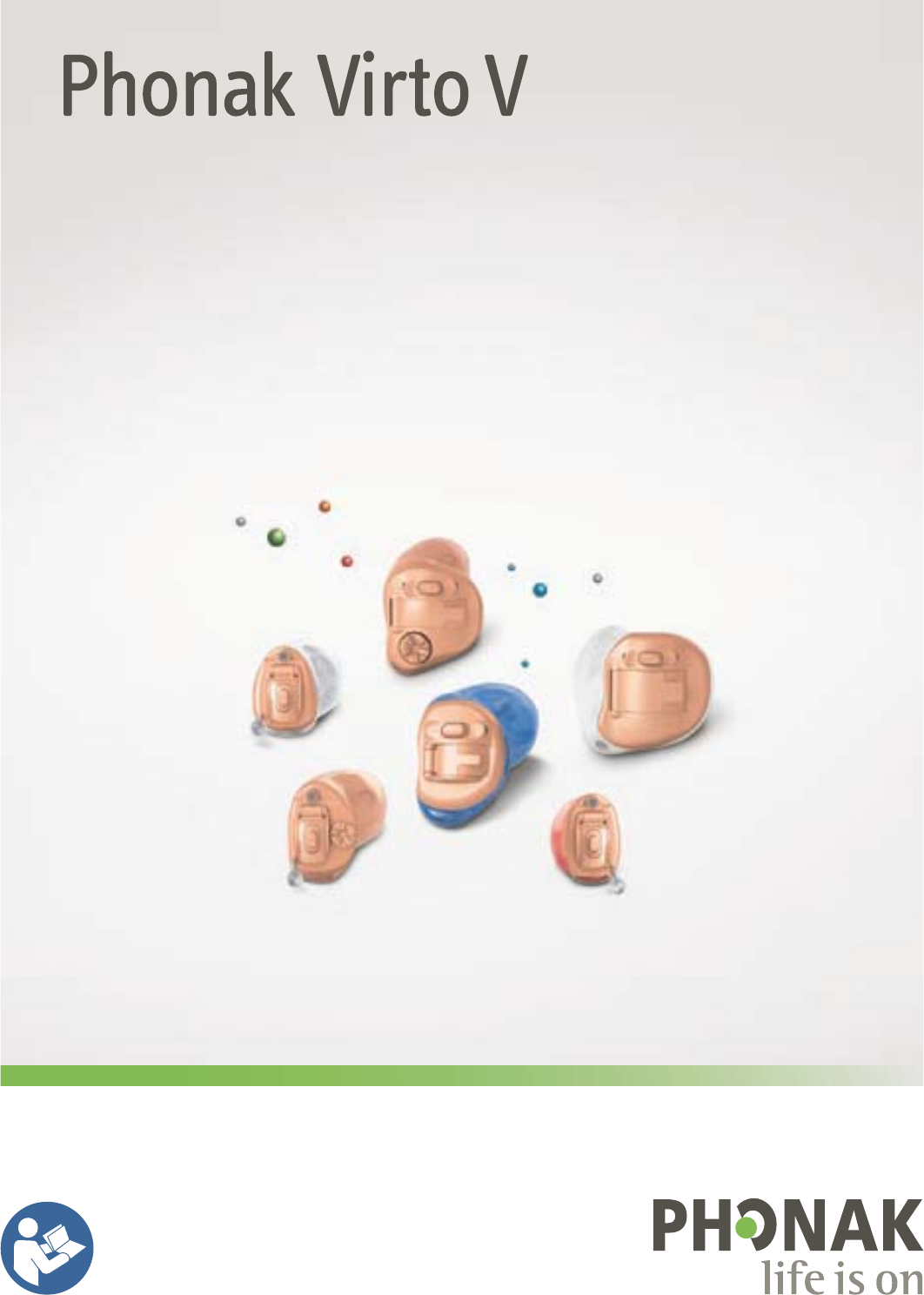
User Guide
(V90/V70/V50/V30)
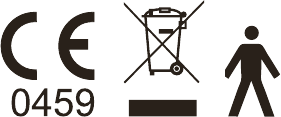
Wireless models
Phonak Virto V90-10 O
Phonak Virto V90-10
Phonak Virto V90-312
Phonak Virto V90-13
Phonak Virto V70-10 O
Phonak Virto V70-10
Phonak Virto V70-312
Phonak Virto V70-13
Phonak Virto V50-10 O
Phonak Virto V50-10
Phonak Virto V50-312
Phonak Virto V50-13
Phonak Virto V30-10 0
Phonak Virto V30-10
Phonak Virto V30-312
Phonak Virto V30-13
CE mark applied
2015
2015
2015
2015
2015
2015
2015
2015
2015
2015
2015
2015
2015
2015
2015
2015
This user guide is valid for:
3
Non wireless models
Phonak Virto V90-nano
Phonak Virto V90-10 NW O
Phonak Virto V70-nano
Phonak Virto V70-10 NW O
Phonak Virto V50-nano
Phonak Virto V50-10 NW O
Phonak Virto V30-10 NW O
CE mark applied
2015
2015
2015
2015
2015
2015
2015

5
Your hearing aid details
Model
F Phonak Virto V-nano
F Phonak Virto V-10 NW O
F Phonak Virto V-10 O
F Phonak Virto V-10
F Phonak Virto V-312
F Phonak Virto V-13
Battery type
10
10
10
10
312
13
If no box is checked and you do not know the
model of your hearing aid, please ask your hearing
care professional.
Your hearing care professional:

Your hearing aids have been developed by
Phonak – the world leader in hearing solutions based
in Zurich, Switzerland.
These premium products are the result of decades of
research and expertise and are designed to keep you
connected to the beauty of sound! We thank you for
making such a great choice and wish you many years
of listening pleasure.
Please read the user guide carefully to make sure that
you understand and get the best out of your hearing aids.
For more information about features and benets, simply
contact your hearing care professional.
Phonak – life is on
www.phonak.com
Download the Phonak Support App
To have an individual and interactive user guide
always with you, download the Phonak Support App
on your mobile device. For more information please
visit: www.phonak.com/supportapp

7
Contents
Your hearing aid
1. Quick guide
2. Parts of the hearing aid
Using the hearing aid
3. Left & right hearing aid markings
4. On/O
5. Batteries
6. Putting on the hearing aid
7. Removing the hearing aid
8. Push button
9. Volume control
10. Adjusting Virto V-nano with Phonak MiniControl
Further Information
11. Care and maintenance
12. Wireless accessories
13. Service and warranty
14. Compliance information
15. Information and description of symbols
16. Troubleshooting
17. Important safety information
8
10
12
13
14
16
17
19
20
21
23
26
29
31
35
38
40
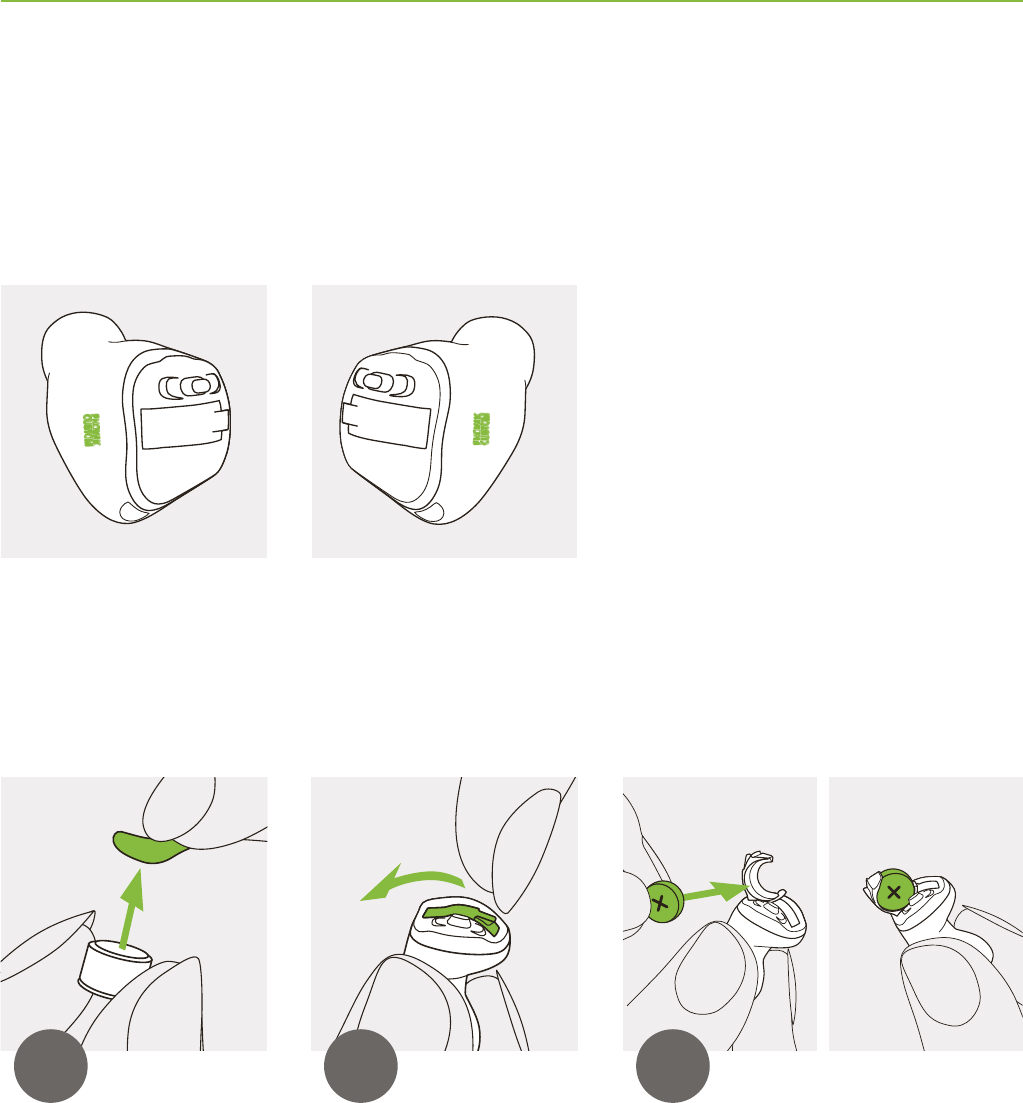
8
1. Quick guide
Left & right hearing aid markings
Changing batteries
Blue marking for left
hearing aid.
Red marking for right
hearing aid.
Remove the
sticker from the
new battery.
Left Right
Open the
battery door.
Place battery in the
battery door with the
“+” symbol facing
upwards.
1 2 3
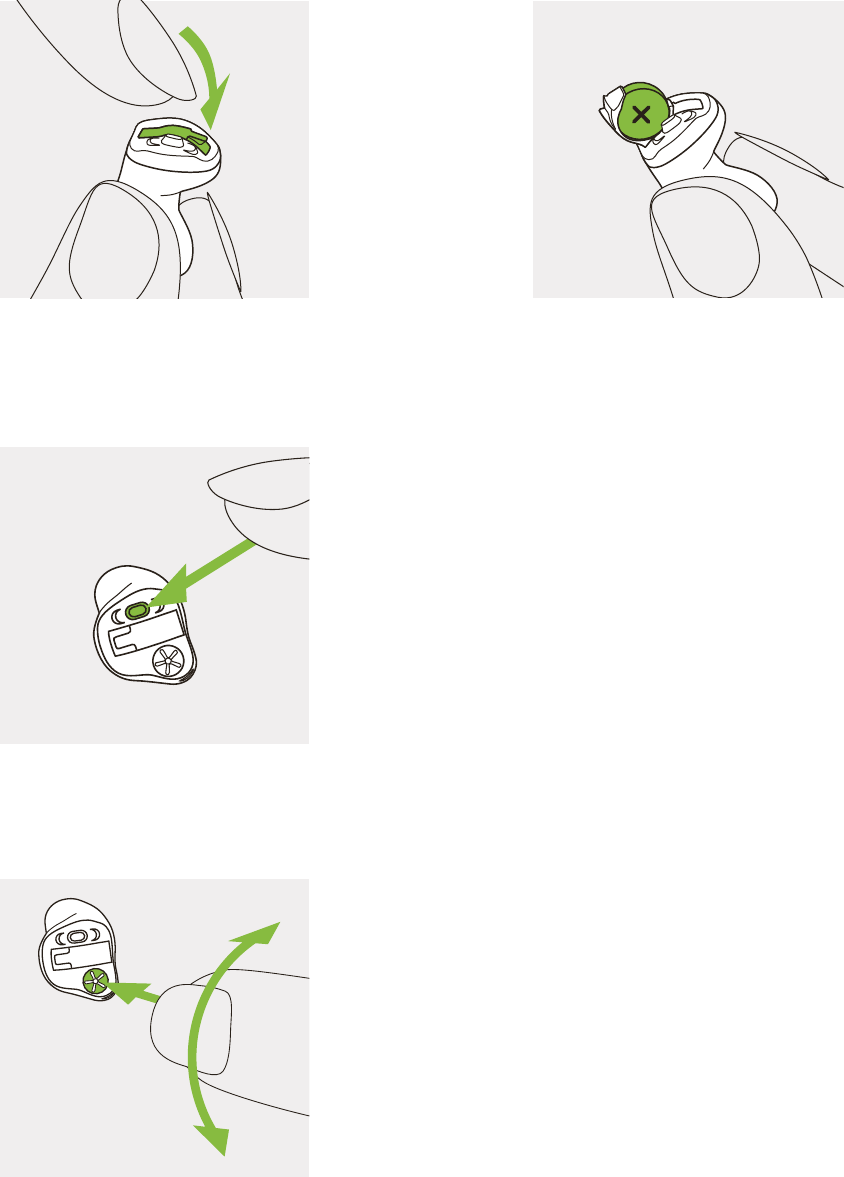
9
On/O
Push button
Volume control
Models with this option only:
The push button on your hearing aid
can have various functions.
Models with this option only:
To increase the volume, turn the
volume control forwards. To decrease
the volume, turn the volume control
backwards.
OOn

10
2. Parts of the hearing aid
The pictures below show the models described in this user
guide. You can identify your personal model by:
• Checking “Your hearing aid details” on page 5.
• Or comparing your hearing aid with the following
shown models. Pay attention to the shape of the
hearing aid and if a volume control is present.
Virto V-nano, V-10 O and V-10 NW O
Custom made
shell
Battery door
Push button
(optional)
Removal handle
Sound output / wax protection system
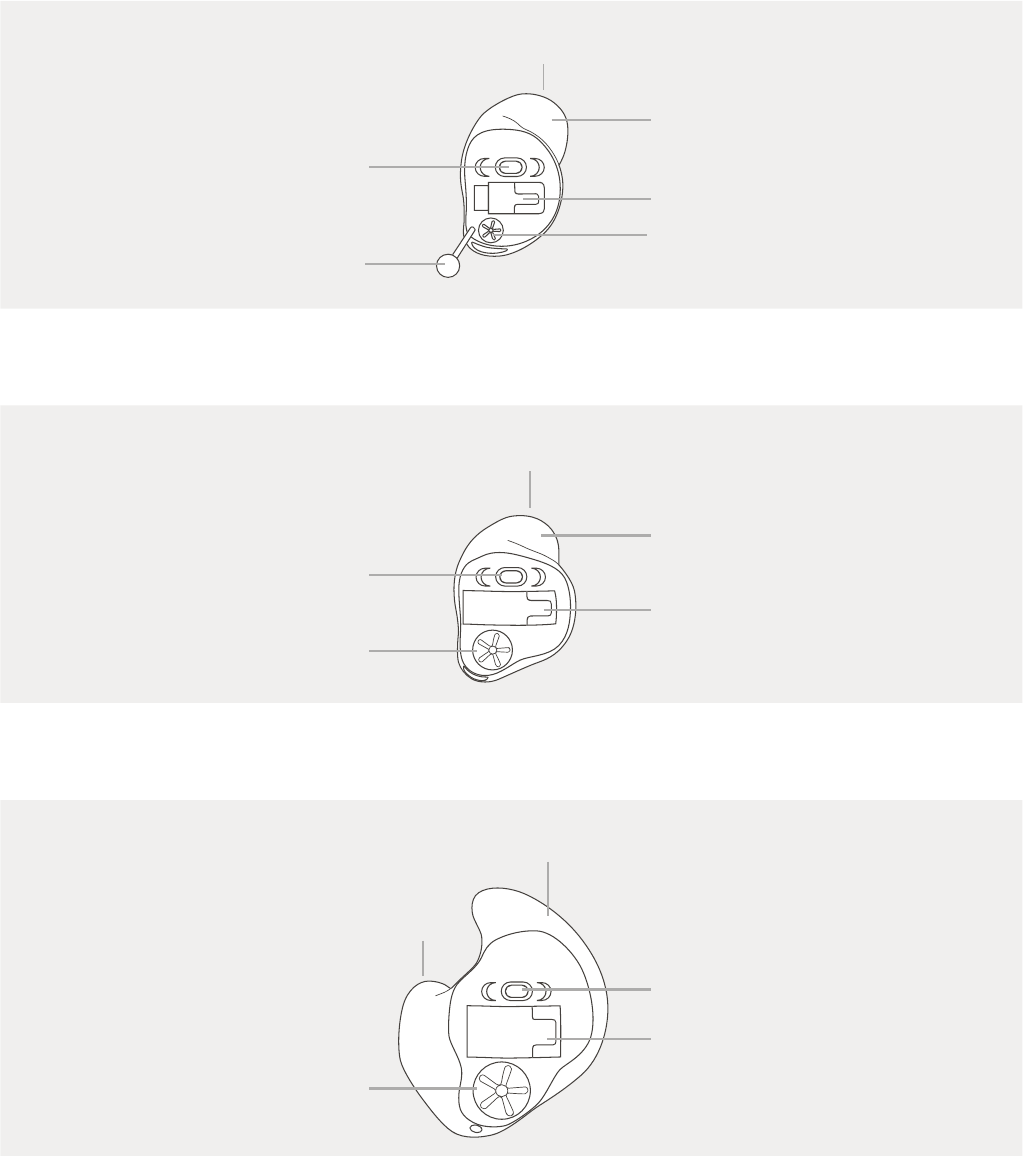
11
Virto V-10
Custom made
shell
Battery door
Volume control
(optional)
Push button
Removal handle
Sound output / wax protection system
Virto V-312
Virto V-13
Battery door
Push button
Sound output /
wax protection system
Custom made shell
Volume control
(optional)
Battery door
Custom
made shell
Push button
Sound output / wax protection system
Volume control
(optional)
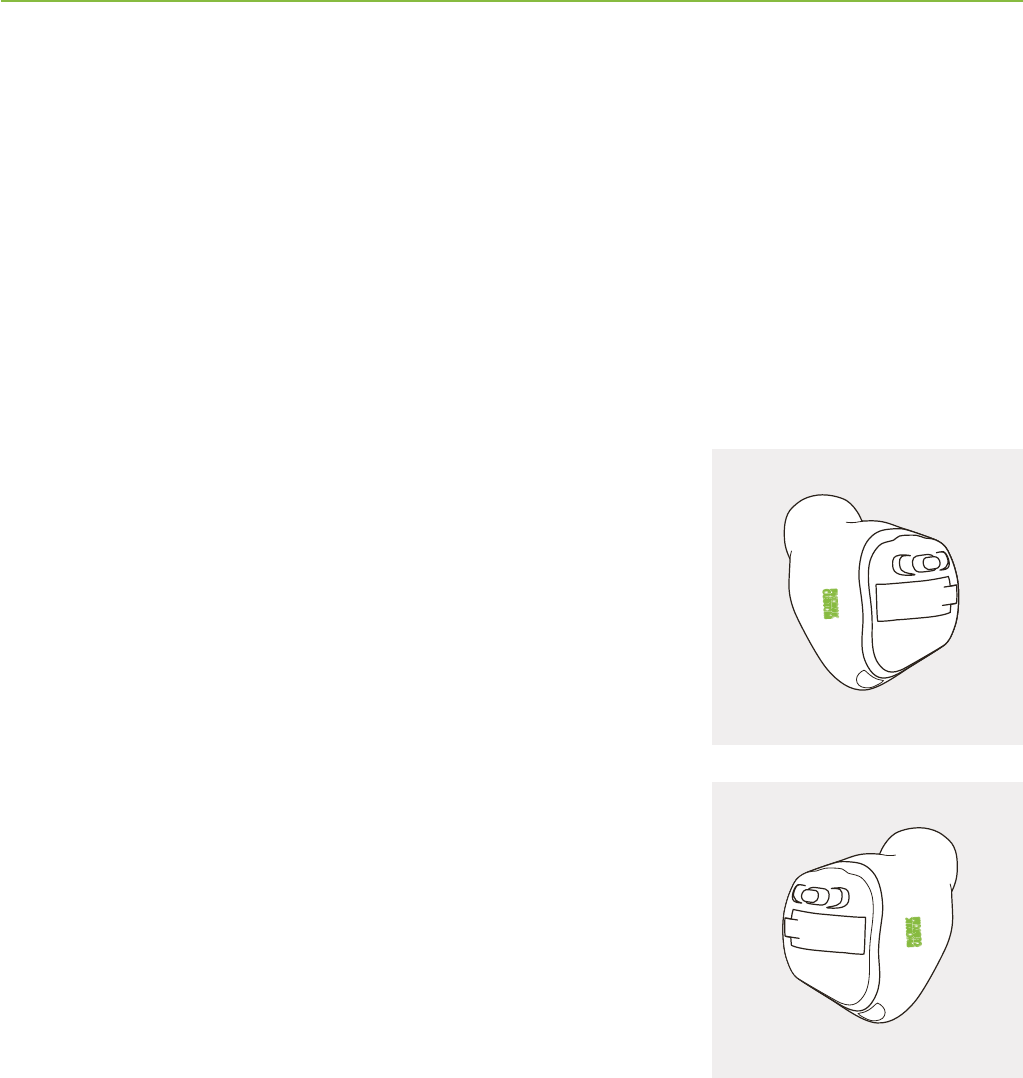
12
3. Left & right hearing aid markings
There is a red or blue marking to tell you if it is a left or a
right hearing aid. The color mark is located on the shell
(text printed in red or blue), or shell is colored
red or blue.
Blue marking for left hearing aid.
Red marking for right hearing aid.
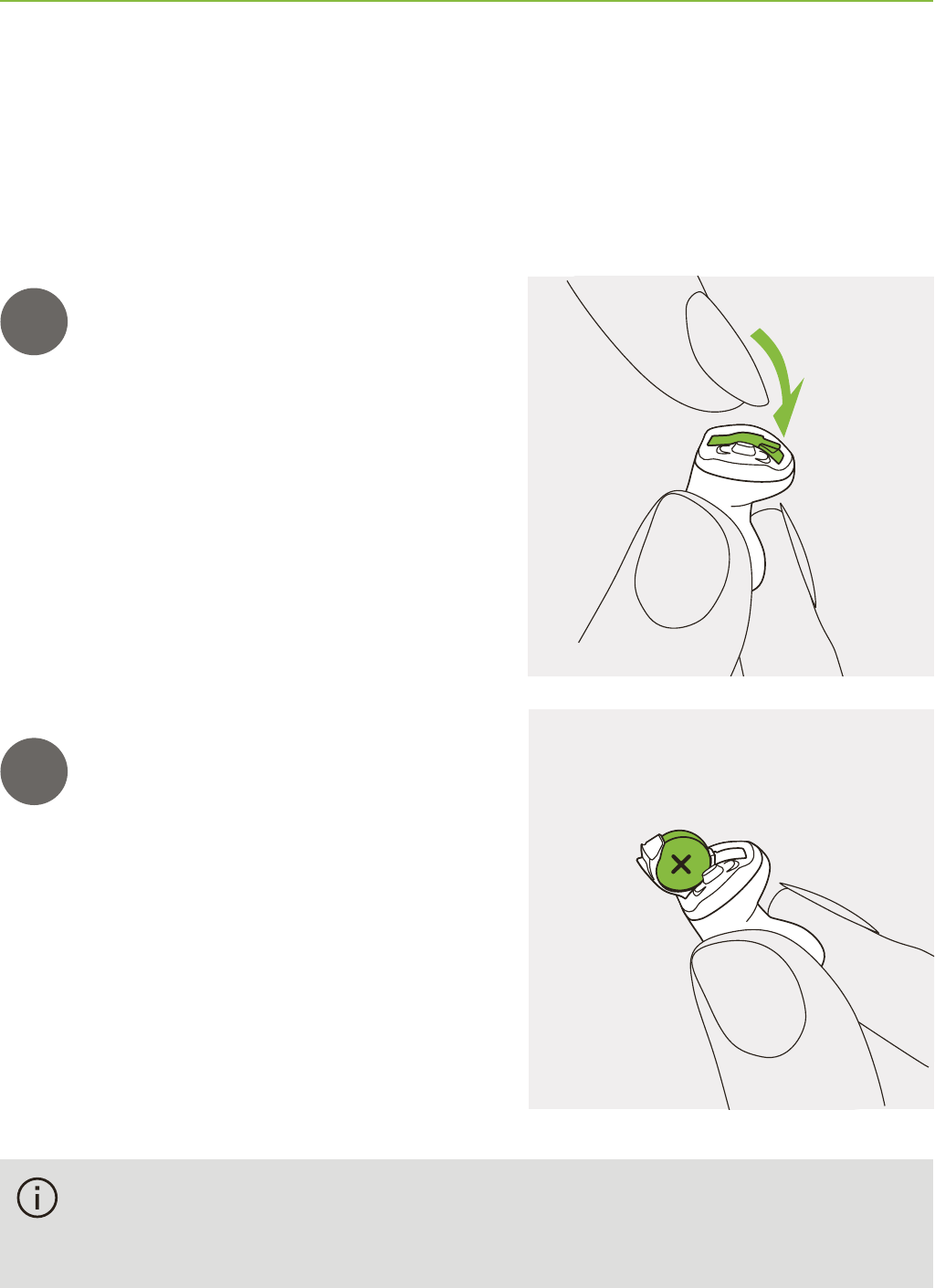
13
4. On/O
The battery door is also the on/o switch.
1
2
Closed battery door =
hearing aid is on
Opened battery door =
hearing aid is o
When you switch on the hearing aid you may hear
a start-up melody.
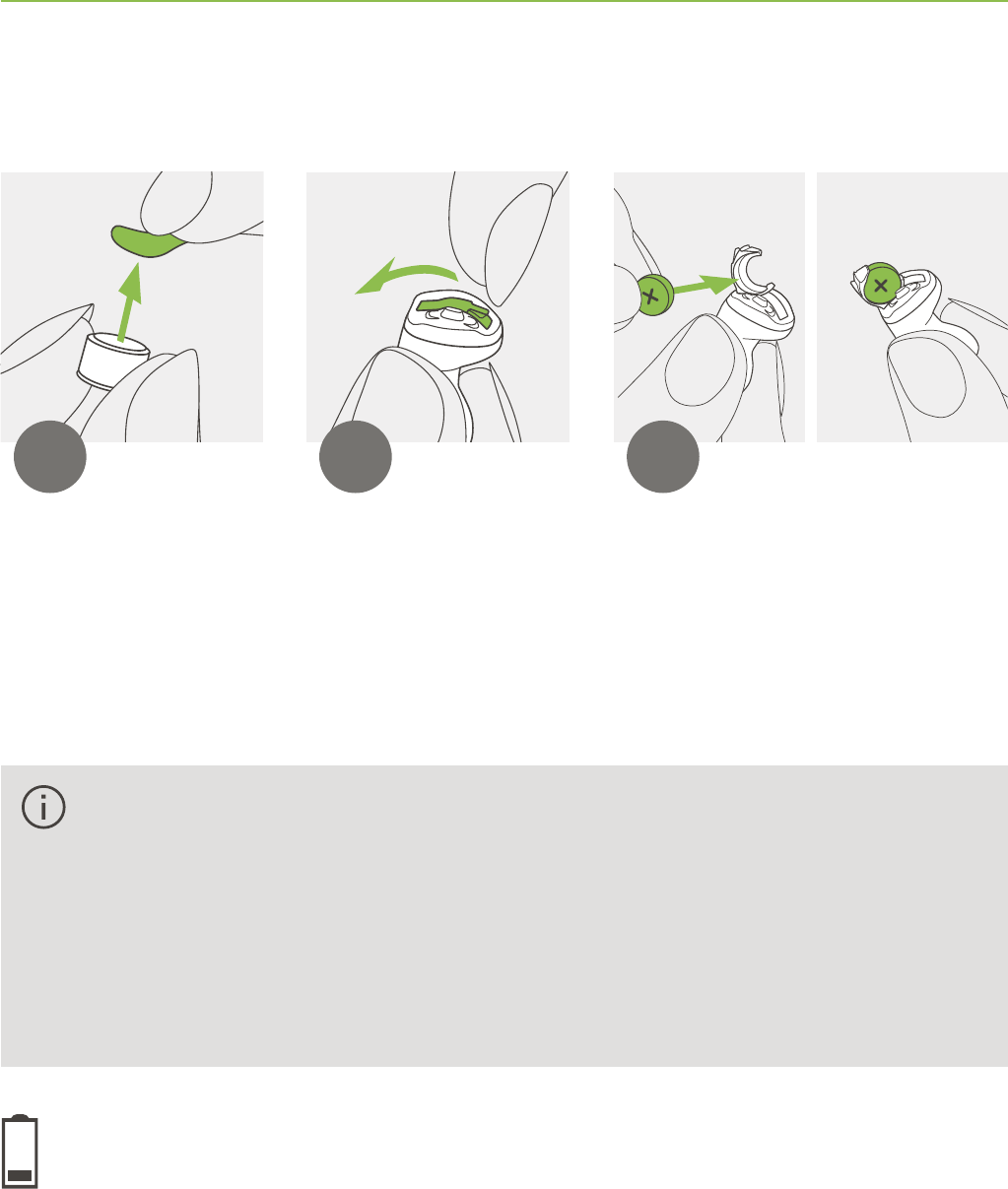
14
5. Batteries
Remove the
sticker from the
new battery.
Open the
battery door.
Place battery in the
battery door with the
“+” symbol facing
upwards.
Low power: You will hear two beeps when the battery
is low. You will have approximately 30 minutes to
change the battery (this can vary, depending on the
hearing aid settings and battery). We recommend that
you always have a new battery on hand.
If it is dicult to close the battery door: Check that
the battery is inserted correctly and the “+” symbol
is facing upwards. If the battery is not inserted
correctly, the hearing aid will not work and the
battery door can be damaged.
1 2 3
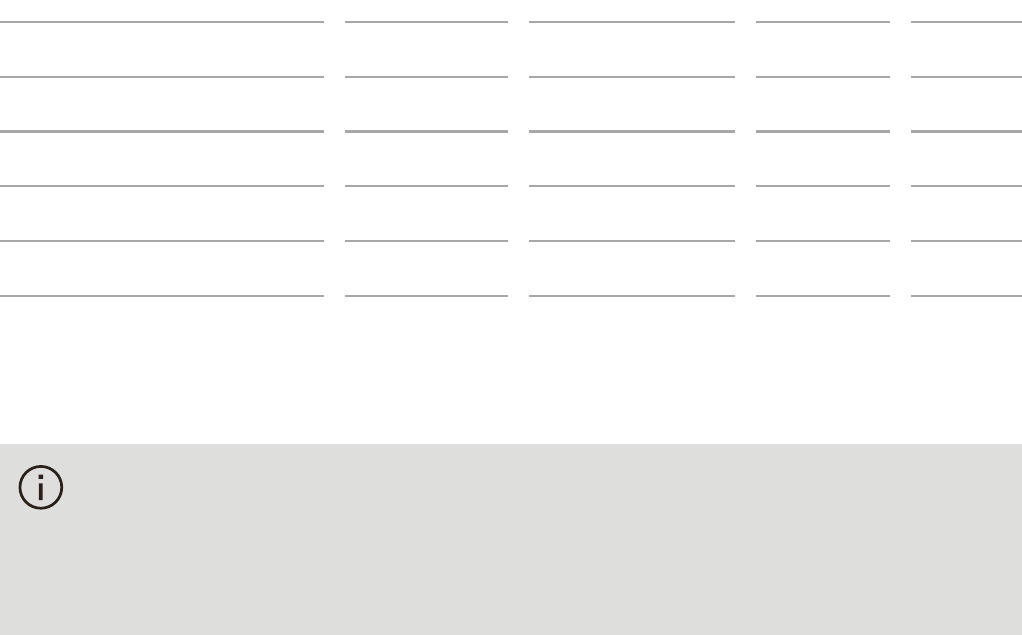
15
Model
Phonak Virto
V-nano
V-10 NW O
V-10 O, V-10
V-312
V-13
Zinc air
battery
size
10
10
10
312
13
Color
marking on
package
yellow
yellow
yellow
brown
orange
IEC
code
PR70
PR70
PR70
PR41
PR48
ANSI
code
7005ZD
7005ZD
7005ZD
7002ZD
7000ZD
Replacement battery
This hearing aid requires zinc-air batteries. Identify the
correct battery size (10, 312 or 13) by:
• Checking “Your hearing aid details” on page 5.
• Checking the marking on the inner side of the
battery door.
• Checking the following table.
Please ensure you use the correct type of battery in
your hearing aids (zinc-air). Please also read chapter
17.2 for further information on product safety.
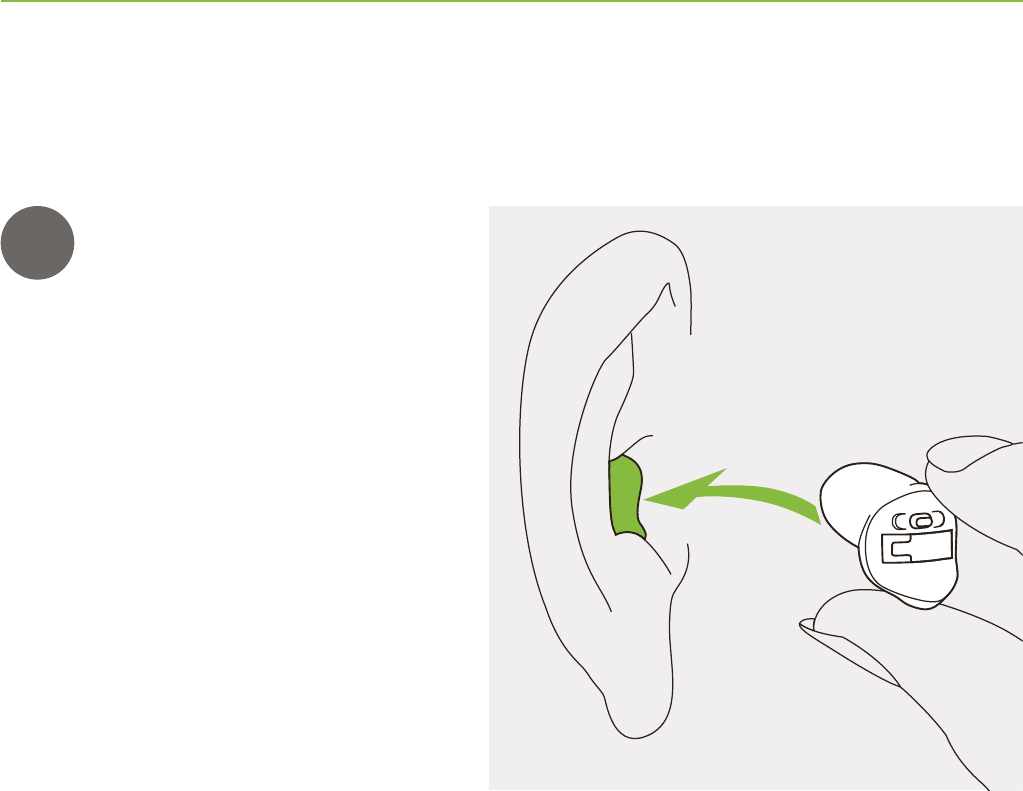
16
6. Putting on the hearing aid
(all models)
1
Take your hearing aid up
to your ear and place the
ear canal part into your
ear canal.
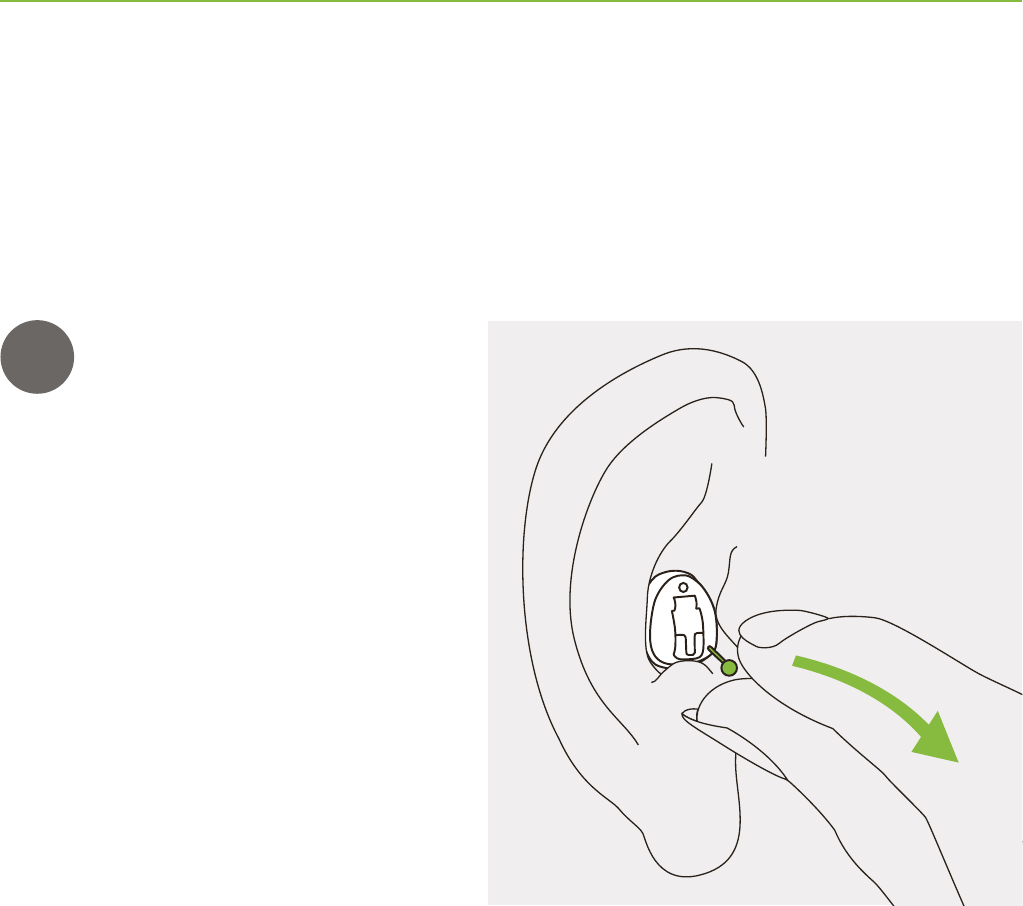
17
7. Removing the hearing aid
7.1 Removing the hearing aid with a removal handle
1
Hold the removal handle
and carefully pull the
hearing aid up and out
of the ear.
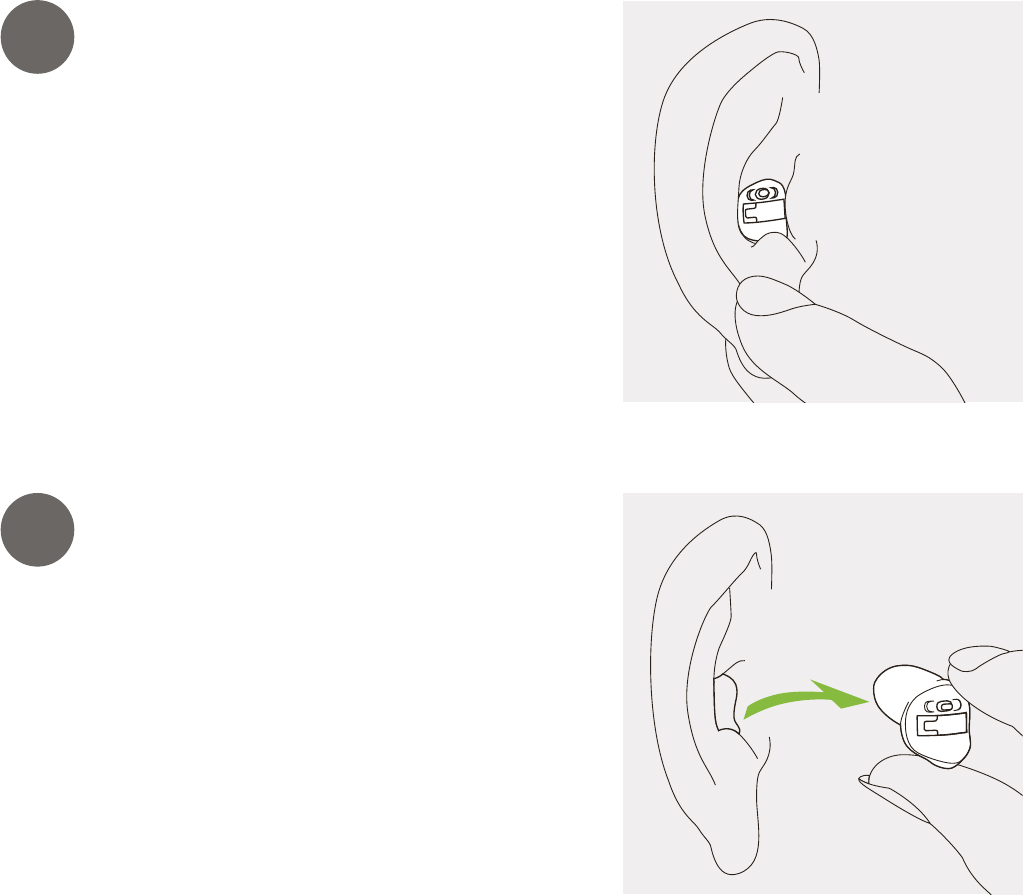
18
1
2
Put your thumb behind your
lobe and gently press your ear
upward to push the hearing aid
out of the canal. In order to help
it along, make chewing
movements with your jaw.
Grasp the protruding hearing aid
and remove it.
7.2 Removing the hearing aid without a
removal handle
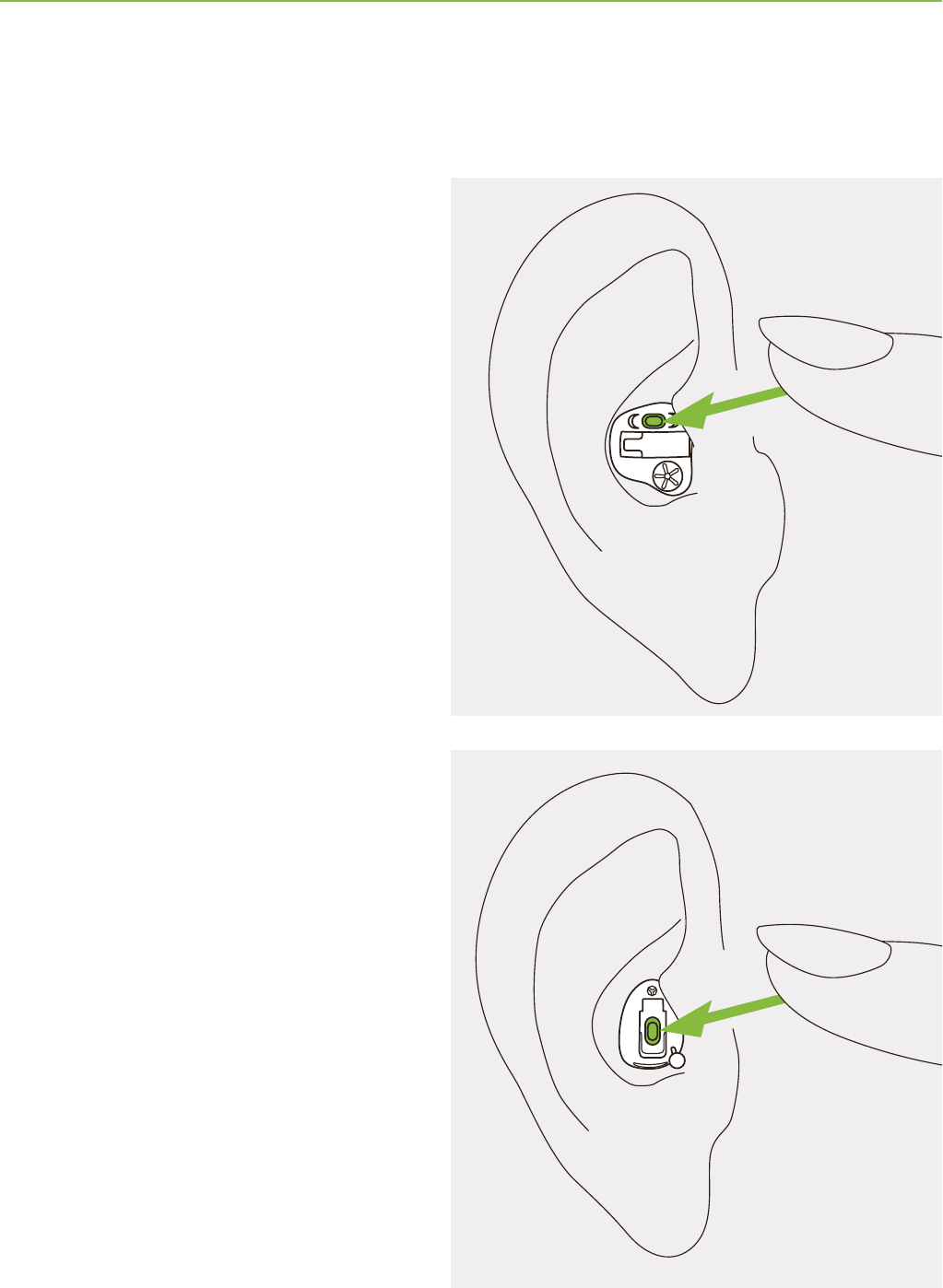
19
8. Push button
Models with this
option only:
The push button on your
hearing aid can have
various functions or is
not active. This depends
on the programming of
the hearing aid, which is
indicated in your
individual “Hearing aid
instructions”. Please ask
your hearing care
professional for this
printout.
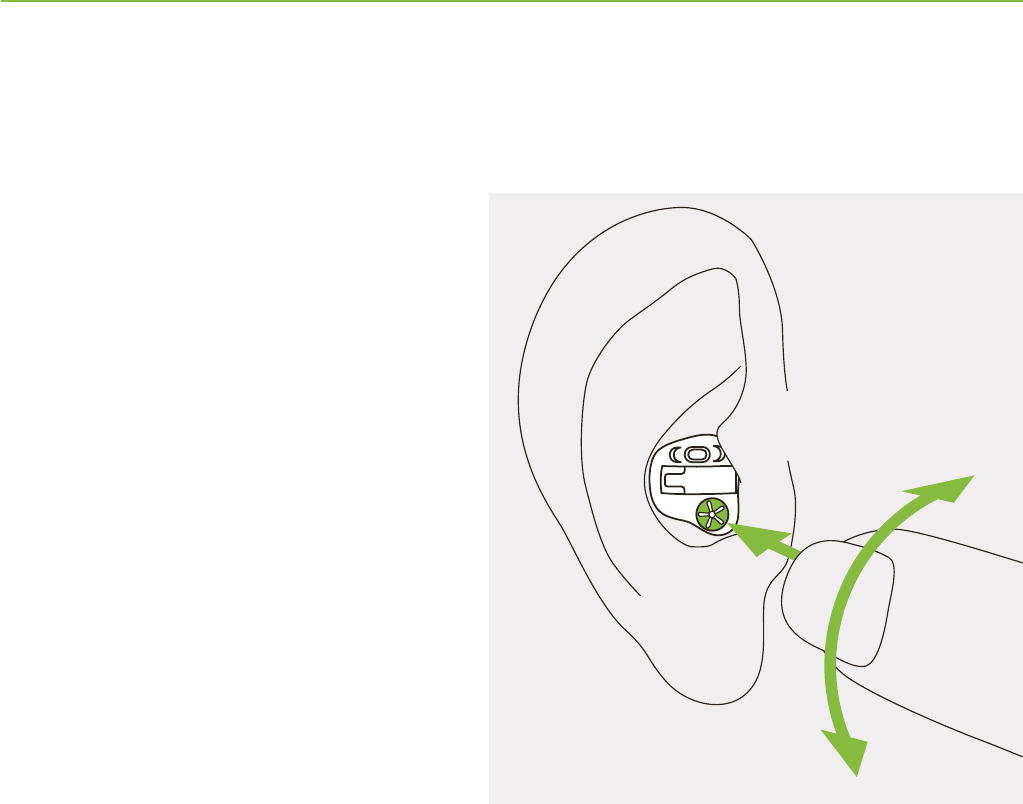
20
9. Volume control
Models with this
option only:
To increase the volume,
turn the volume control
forwards. To decrease the
volume, turn the volume
control backwards. The
volume control can be
disabled by the hearing
care professional.
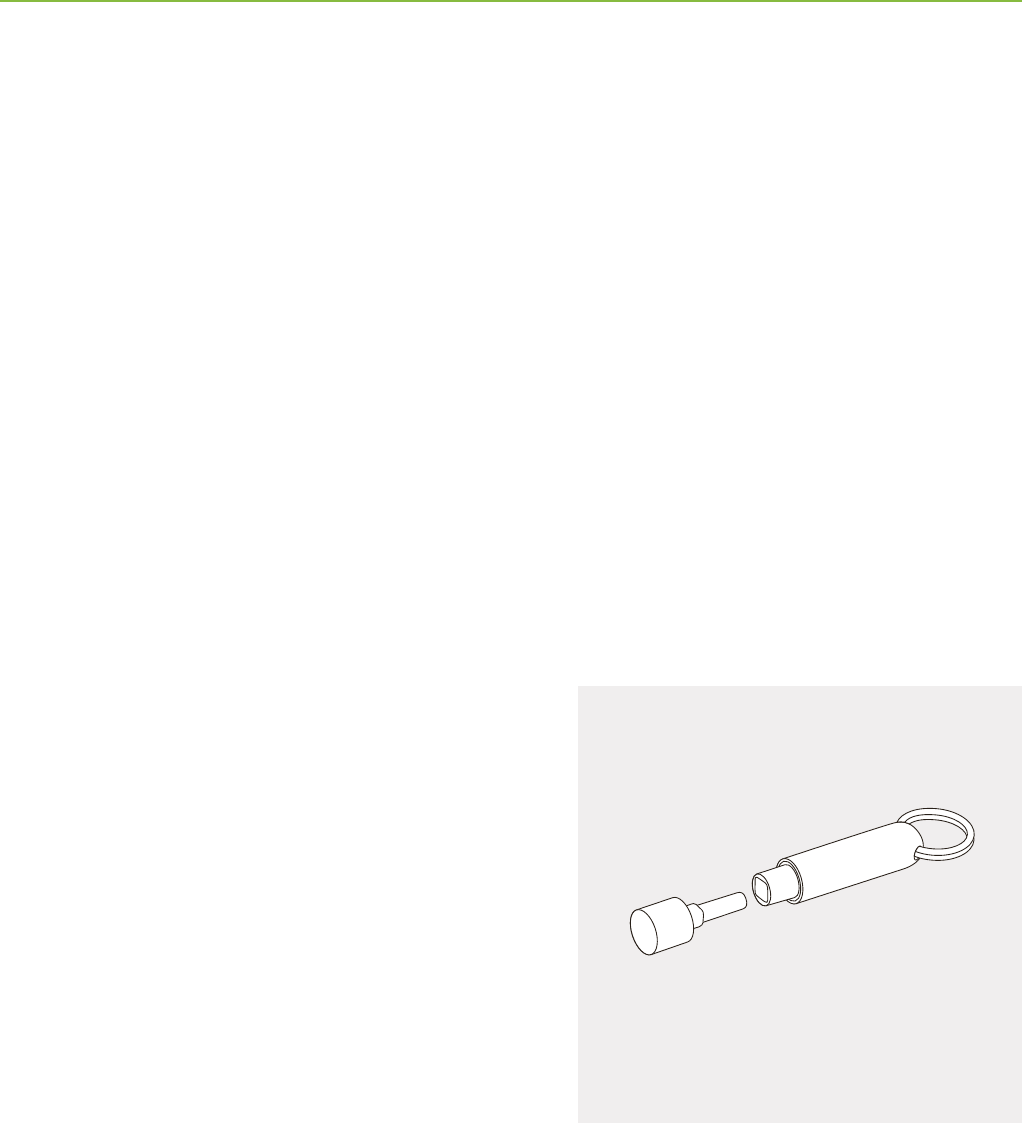
21
10. Adjusting Virto V-nano with
Phonak MiniControl
The MiniControl contains a magnet that functions like a
remote control to change the settings of your Virto V-nano.
Your nano in combination with MiniControl can have
various functions or can remain inactive. This depends on
your individual settings, which are indicated in your
individual “Hearing aid instructions”. Please ask your
hearing care professional for this print out.
To use the MiniControl,
unscrew the magnet from the
keychain housing and hold it
inside the ear canal without
touching the hearing aid.
MiniControl magnet
Keychain housing
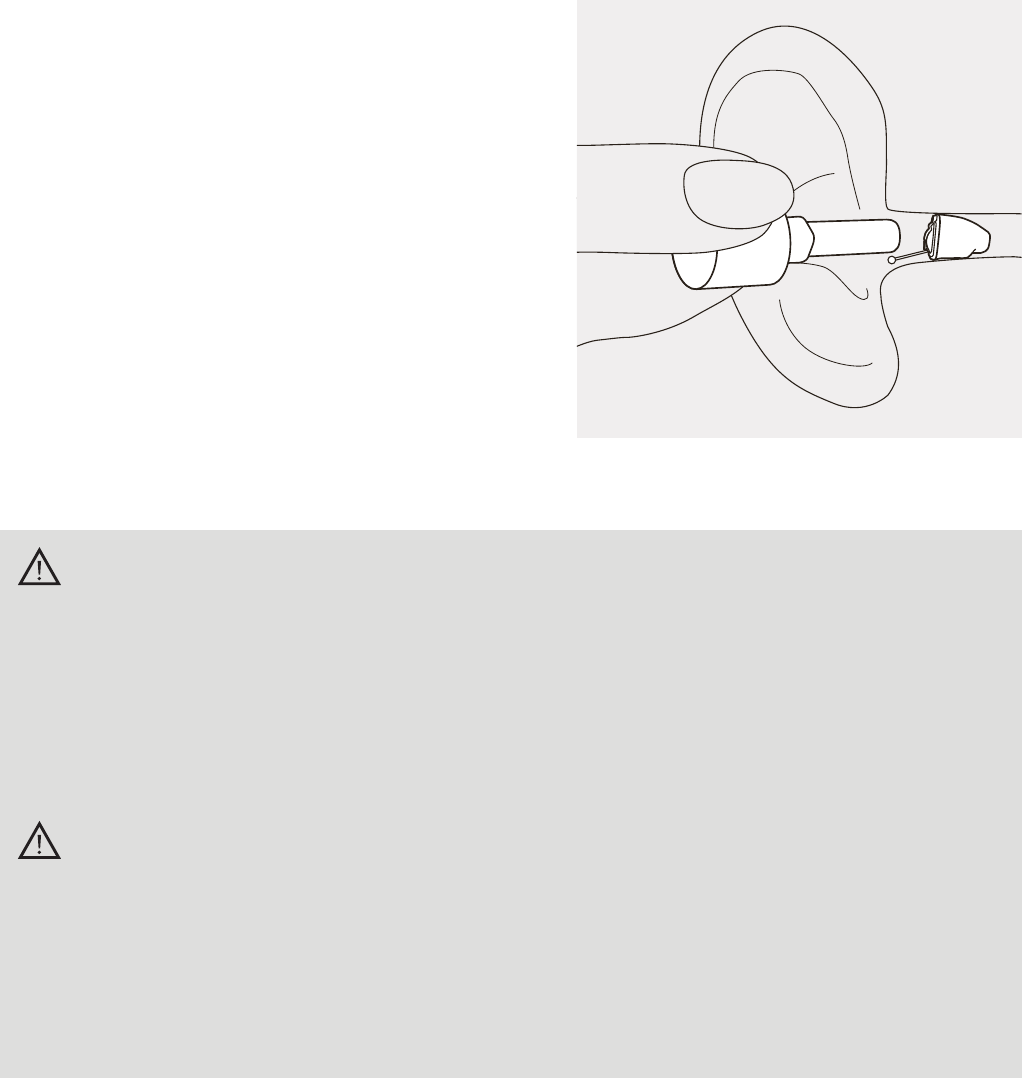
22
If you use a medical device like a pacemaker or ICD
device (implantable cardioverter debrillator), please
read the specic user guide to clarify possible
impact of magnetic elds to your medical device.
Do not place the MiniControl (neither open nor
closed) in your breast pocket. Keep a distance of at
least 15 cm (6 inches) between the MiniControl and
any medical device.
While the hearing aid is on,
hold the magnet inside the
ear canal without touching
the hearing aid.
Promtly remove the magnet
as soon as your nano is in the
desired program or the
volume is ideal for you.

23
11. Care and maintenance
Diligent and routine care of your hearing aid contributes
to outstanding performance and a long service life.
Please use the following specications as a guideline.
For further information regarding product safety, see
chapter 17.2.
General information
Before using hair spray or applying cosmetics, you should
remove your hearing aid from your ear, because these
products may damage it.
24
Daily
Daily cleaning and the use of a drying system is highly
recommended. C&C line from Phonak is a complete set of
cleaning products. Your hearing care professional will be
glad to advise you. Never use household cleaning
products (washing powder, soap, etc.) to clean your
hearing aids.
If your hearing aid is performing weakly or fails to
operate, clean or replace the wax guard system. If your
hearing aid fails to operate after you have correctly
cleaned or replaced your wax protection system and
inserted new batteries, contact your hearing care
professional for advice.
Weekly
For more in depth maintenance instructions or for
more than basic cleaning, please see your hearing
care professional.
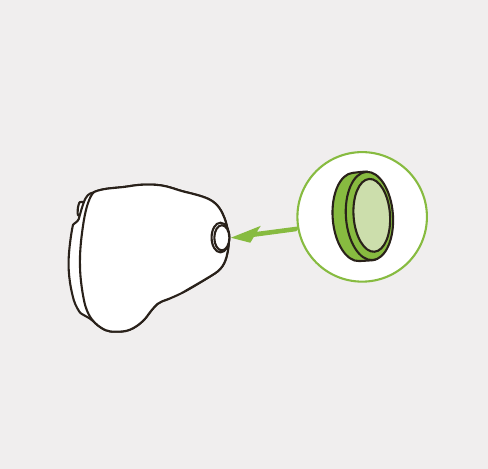
25
Wax protection
SmartGuard is a unique
wax protection system
developed by Phonak. The
unique membrane design
completely protects your
hearing aid from wax
and moisture.
Cerustop wax guards are
also commonly used as
an alternative protection
system. Please ask your
hearing care professional
for detailed information
on the use of the wax
protection system on
your hearing aid.
SmartGuard
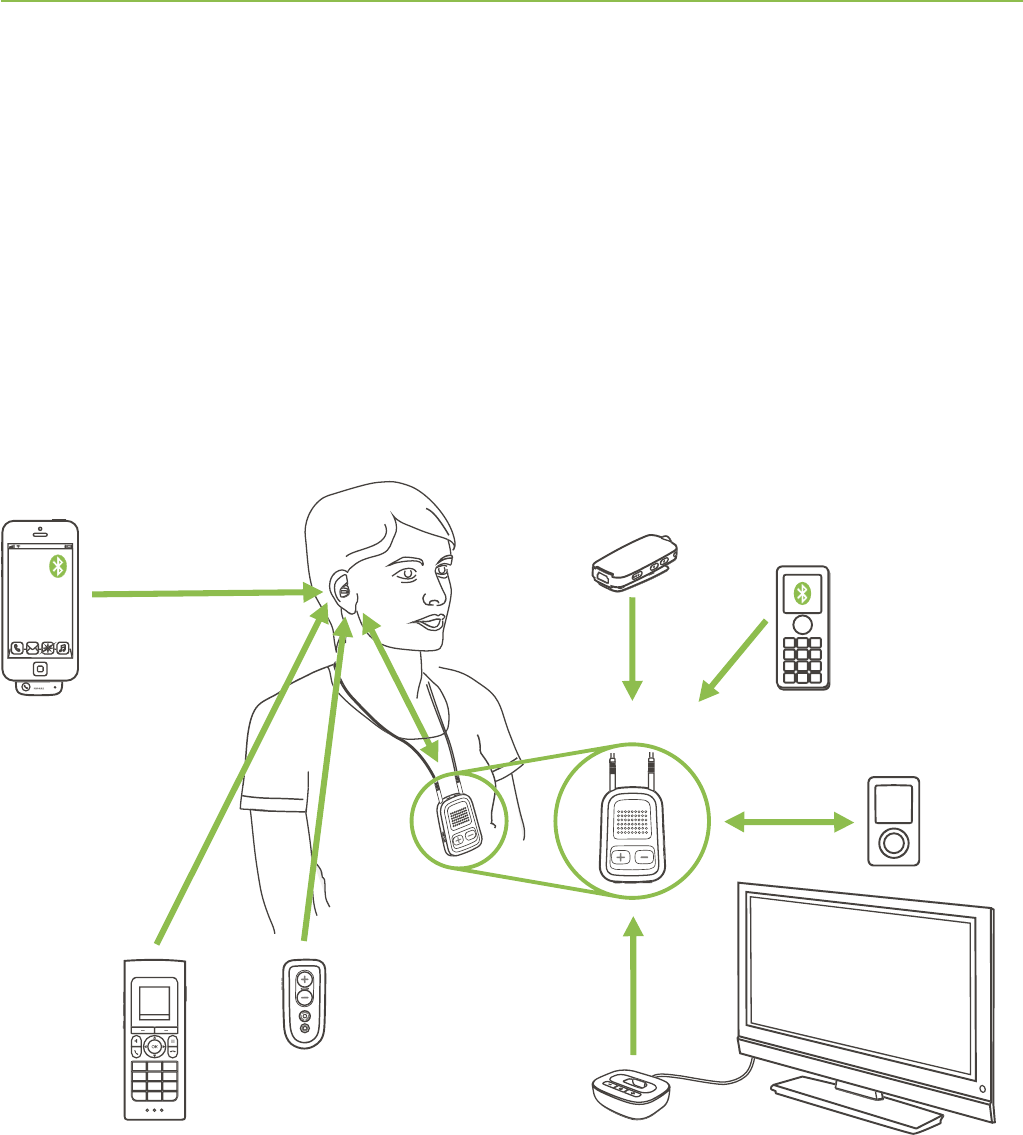
26
12. Wireless accessories
12.1 Connecting to audio sources and
remote control
A range of Phonak accessories are available for you to
use with your wireless hearing aid.
* The Phonak ComPilot with neckloop or ComPilot Air with clip to attach to clothing. They also
have basic remote control functionalities. For advanced control they can be used with the
Phonak RemoteControl App.
** Audio sources (e.g. MP3 Player, computer, laptop, tablet) can be connected to the streaming
device via Bluetooth or audio cable.
*** Clipped onto the speaker’s clothing for better understanding over distance.
Cell phone
Phonak streaming device*
Phonak EasyCall
with cell phone
Phonak RemoteMic***
MP3 Player/
Audio source**
Phonak TVLink connected to TV
Phonak PilotOne
remote control
Phonak DECT phone
27
12.2 Communication in noise and over distance
The Roger portfolio provides an outstanding microphone
performance to help you better understand in noise and
over distance. With Roger you can benet from:
• understanding every word in a noisy situation e.g.
restaurants, public areas and over distance
• discreet design
• speech transmission directly to your hearing aids with
attached receiver or via your body-worn receiver
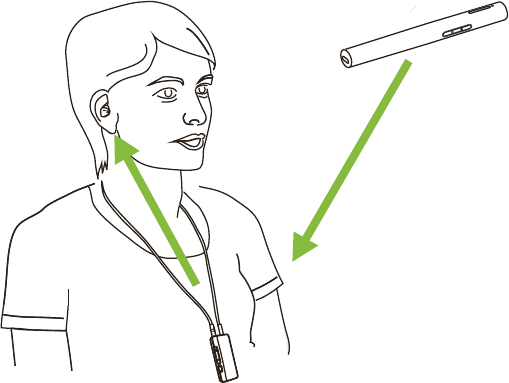
28
Microphone*
Body-worn receiver option
Note: Only available for Virto V models with telecoil
* Some Roger microphones also support input from audio sources via Bluetooth® or cable.
Bluetooth® is a registered trademark owned by the Bluetooth SIG, Inc.

29
13. Service and warranty
Local warranty
Please ask the hearing care professional, where
you purchased your hearing aid, about the terms
of the local warranty.
International warranty
Phonak oers a one year limited international
warranty, valid starting from the date of purchase.
This limited warranty covers manufacturing and
material defects in the hearing aid itself, but not
accessories such as batteries, tubes, earmolds and
external receivers. The warranty only comes into
force if a proof of purchase is shown.
The international warranty does not aect any legal
rights that you might have under applicable national
legislation governing sale of consumer goods.

30
Warranty limitation
This warranty does not cover damage from improper
handling or care, exposure to chemicals or undue stress.
Damage caused by third parties or non-authorized service
centers renders the warranty null and void. This warranty
does not include any services performed by a hearing care
professional in their oce.
Serial number
(left side):
Serial number
(right side):
Date of purchase:
Authorized hearing care
professional (stamp/signature):

31
Europe:
Declaration of Conformity
Hereby Phonak AG declares that this Phonak product
meets the requirements of the Medical Devices Directive
93/42/EEC as well as the Radio and Telecommunications
Terminal Equipment Directive 1999/5/EC. The full text of
the Declaration of Conformity can be obtained from the
manufacturer or the local Phonak representative whose
address can be taken from the list on www.phonak.com
(Phonak worldwide locations).
Australia:
Supplier Code Number N15398
New Zealand:
Supplier Code Number Z1285
14. Compliance information

32
The wireless models listed on page 2 are
certied under:
Phonak Virto V-10 O, models M / P / SP
USA FCC ID: KWC-ITEV10O
Canada IC: 2262A-ITEV10O
Phonak Virto V-10, models M / P / SP
USA FCC ID: KWC-ITEV10
Canada IC: 2262A-ITEV10
Phonak Virto V-13 & V-312, models M / P / SP / UP
USA FCC ID: KWC-ITEV13
Canada IC: 2262A-ITEV13
33
Notice 1:
This device complies with Part 15 of the FCC Rules
and with RSS-210 of Industry Canada. Operation is
subject to the following two conditions:
1) this device may not cause harmful interference, and
2) this device must accept any interference received,
including interference that may cause undesired operation.
Notice 2:
Changes or modications made to this device not
expressly approved by Phonak may void the FCC
authorization to operate this device.
Notice 3:
This device has been tested and found to comply with
the limits for a Class B digital device, pursuant to Part 15
of the FCC Rules and ICES-003 of Industry Canada.
These limits are designed to provide reasonable protection
against harmful interference in a residential installation.
This device generates, uses and can radiate radio
frequency energy and, if not installed and used in
accordance with the instructions, may cause harmful
34
interference to radio communications. However, there
is no guarantee that interference will not occur in a
particular installation. If this device does cause harmful
interference to radio or television reception, which can
be determined by turning the equipment o and on, the
user is encouraged to try to correct the interference by
one or more of the following measures:
• Reorient or relocate the receiving antenna.
• Increase the separation between the device
and receiver.
• Connect the device into an outlet on a circuit
dierent from that to which the receiver is connected.
• Consult the dealer or an experienced radio/TV
technician for help.
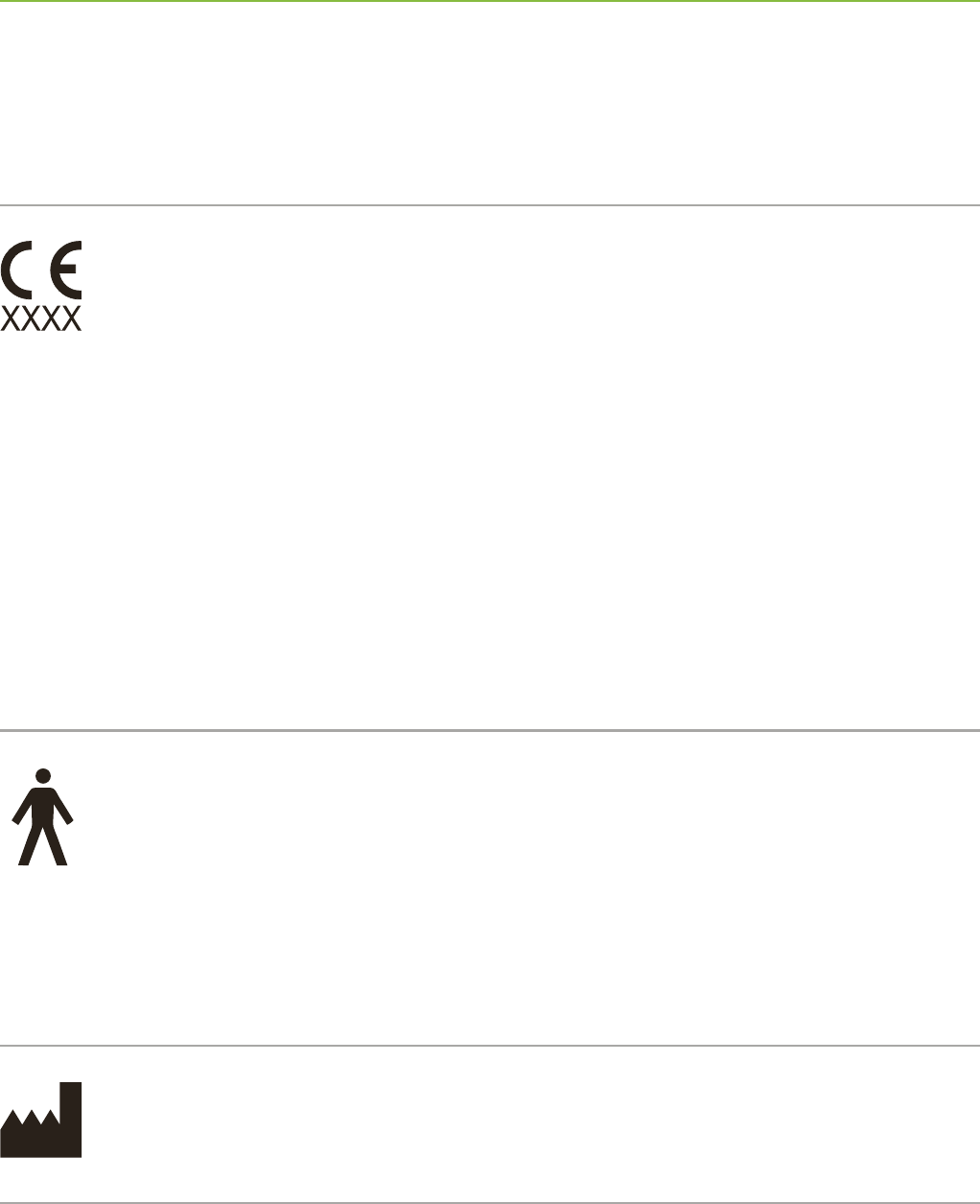
35
With the CE symbol, Phonak AG conrms
that this Phonak product – including
accessories – meets the requirements of the
Medical Devices Directive 93/42/EEC as well as
the R&TTE Directive 1999/5/EC on radio and
telecommunications equipment. The numbers
after the CE symbol correspond to the code of
certied institutions that were consulted under
the above-mentioned directives.
This symbol indicates that the products
described in these user instructions adhere to
the requirements for an applied part of Type B
of EN 60601-1. The surface of the hearing aid
is specied as an applied part of Type B.
Indicates the medical device manufacturer, as
dened in EU Directive 93/42/EEC.
15. Information and description
of symbols
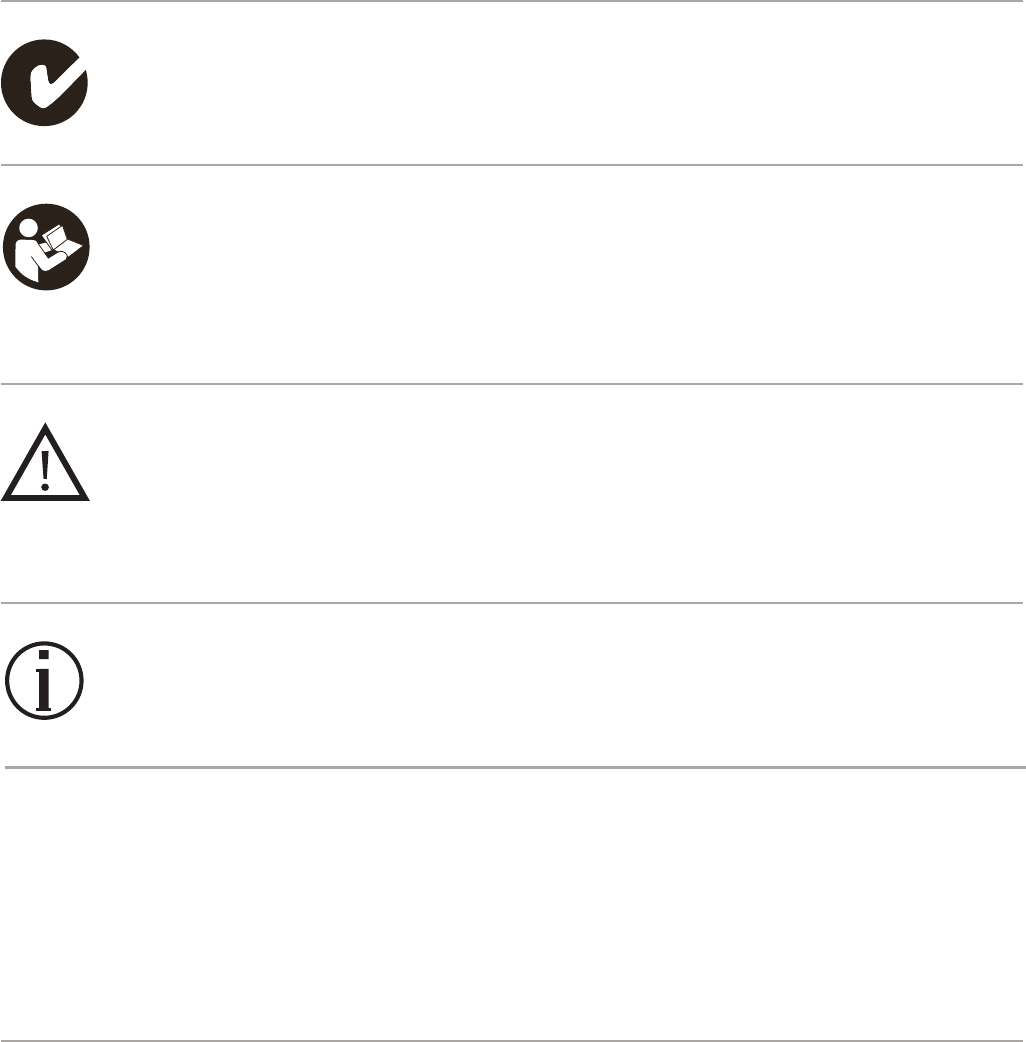
36
EMC and Radio communications compliance
label Australia.
This symbol indicates that it is important for
the user to read and take into account the
relevant information in these user guides.
This symbol indicates that it is important for
the user to pay attention to the relevant
warning notices in these user guides.
Important information for handling and
product safety.
The product is designed such that it functions
without problems or restrictions if used as
intended, unless otherwise noted in these
user guides.
Operating
conditions
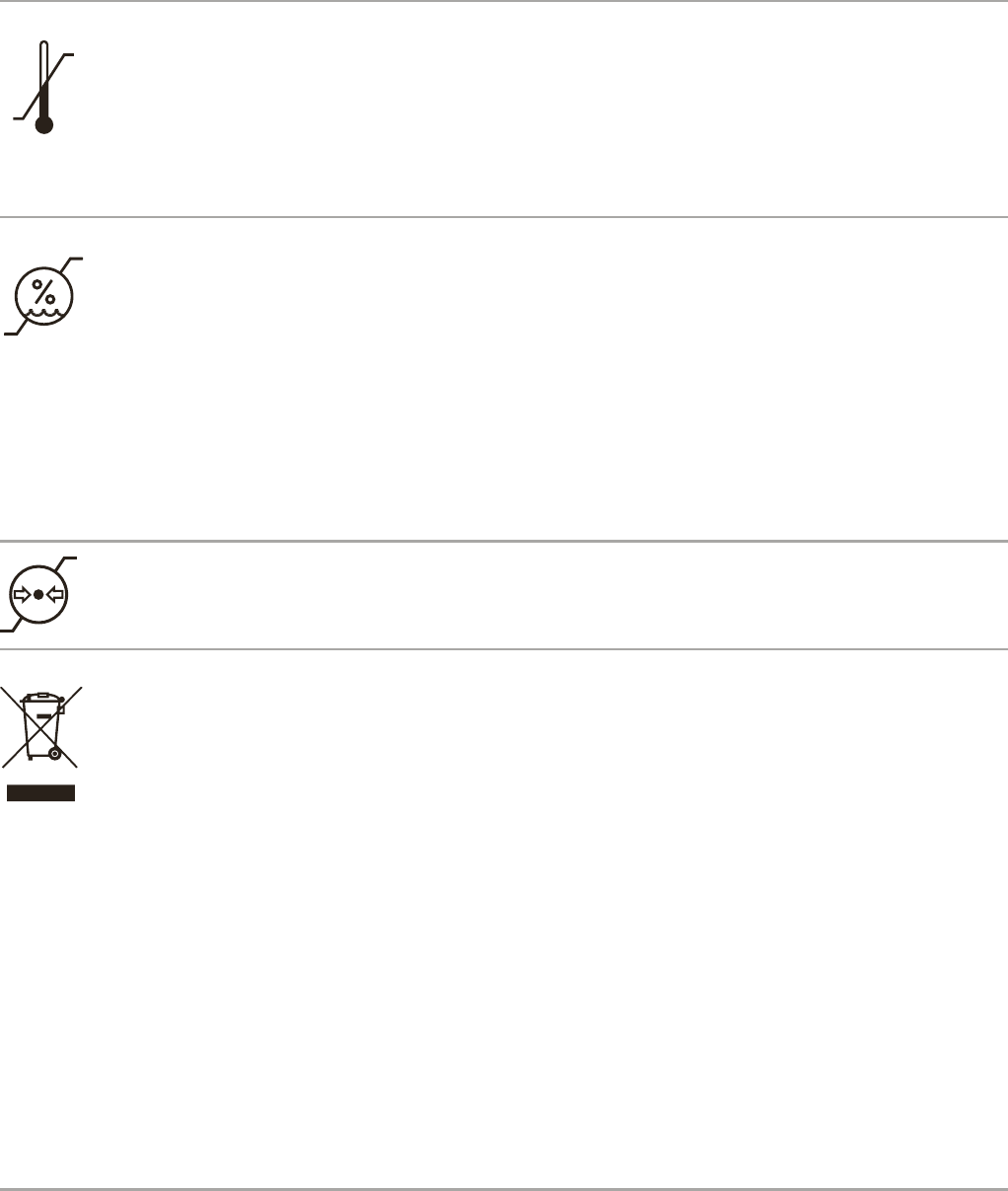
37
Temperature during transportation
and storage: –20° to +60° Celsius
(–4° to +140° Fahrenheit).
Humidity during transportation: Up to 90%
(non condensing).
Humidity during storage: 0% to 70%, if not in
use. See instruction in chapter 17.2 regarding
drying the hearing aid after use.
Atmospheric pressure: 200 hPA to 1500 hPa
The symbol with the crossed-out garbage
bin is to make you aware that this hearing
aid may not be thrown away as normal
household waste. Please dispose of old or
unused hearing aids, at waste disposal sites
intended for electronic waste, or give your
hearing aid to your hearing care professional
for disposal. Proper disposal protects the
environment and health.
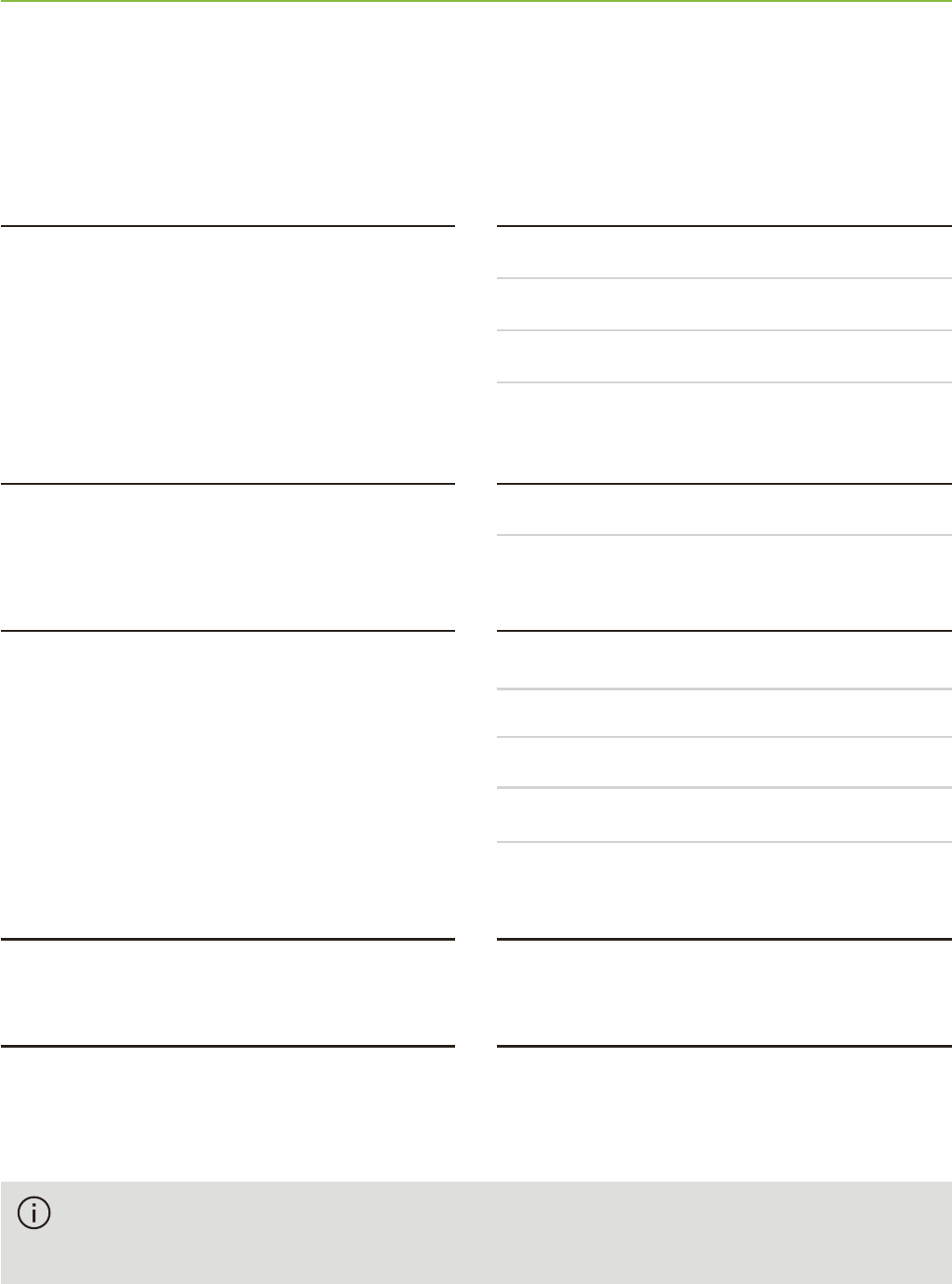
38
16. Troubleshooting
If the problem persists, contact you hearing care
professional for assistance
Causes
Flat battery
Blocked speaker
Battery not inserted correctly
Hearing aid switched o
Hearing aid not inserted correctly
Earwax in ear canal
Volume too loud
Low battery
Blocked speaker
Volume too low
Physical hearing condition
has changed
Indication for low battery
Moisture on battery or
hearing aid
Problem
Hearing aid not functioning
Hearing aid whistles
Hearing aid not loud enough
or distorted
Hearing aid plays two beeps
Hearing aid switches on & o
(intermittent)

39
What to do
Change battery (chapter 1 + 5)
Clean speaker opening
Insert battery correctly (chapter 1 + 5)
Switch hearing aid on by completely closing the battery door
(chapter 4)
Insert hearing aid correctly (chapter 6)
Contact your ENT/GP or hearing care professional
Decrease volume (chapter 8 + 9)
Change battery (chapter 1 + 5)
Clean speaker opening
Turn volume up if volume control available (chapter 8 + 9)
Contact you hearing care professional
Change battery within the next 30 minutes (chapter 1 + 5)
Wipe battery and hearing aid with dry cloth

40
Please read the information on the following pages before
using your hearing aid.
A hearing aid will not restore normal hearing and will not
prevent or improve a hearing impairment resulting from
organic conditions. Infrequent use of a hearing aid does
not permit a user to attain full benet from it. The use of
a hearing aid is only part of hearing habilitation and may
need to be supplemented by auditory training and
instruction in lipreading.
17. Important safety information

41
The intended use of
hearing aids is to amplify
and transmit sound to the
ears and hereby
compensate for impaired
hearing. The hearing aids
(specially programmed for
each hearing loss) must
only be used by the
intended person. They
should not be used by any
other person as they could
damage hearing.
Changes or modications
to the hearing aid that
were not explicitly
approved by Phonak are
not permitted. Such
changes may damage your
ear or the hearing aid.
Do not use the hearing
aids in explosive areas
(mines or industrial areas
with danger of explosions,
oxygen-rich environments
or areas where ammable
anesthetics are handled).
Hearing aid batteries are
toxic if they are swallowed!
Keep out of reach of
children and mentally
challenged people or pets.
If batteries are swallowed,
consult your physician
immediately!
17.1 Hazard warnings

42
If you feel pain in or
behind your ear, if it is
inamed or if skin
irritation and accelerated
accumulations of earwax
occur, please check with
your hearing care
professional or physician.
Hearing programs in the
directional microphone
mode reduce background
noises. Please be aware
that warning signals or
noises coming from
behind, e. g. cars, are
partially or entirely
suppressed.
This hearing aid is not for
children below 36 months.
It contains small parts that
can cause choking, if
swallowed by children.
Keep out of reach of
children and mentally
challenged people or pets.
If swallowed, consult a
physician or hospital
immediately.
External devices may only
be connected if they have
been tested in accordance
with corresponding
IECXXXXX standards. Only
use accessories approved
by Phonak AG, to avoid any
electrical shock.

43
The following is only
applicable for persons with
active implantable medical
devices (i.e. pacemakers,
debrillators, etc.):
Keep the wireless hearing
aid at least 15 cm
(6 inches) away from the
active implant. If you
experience any interference,
do not use the wireless
hearing aids and contact
the manufacturer of the
active implant. Please, note
that interference can also
be caused by power lines,
electrostatic discharge,
airport metal detectors etc.
Keep magnets (i.e. battery
handling tool, EasyPhone
magnet, etc.) at least
15 cm (6 inches) away
from the active implant.

44
Never immerse your hearing
aid in water! Protect it from
excessive moisture. Always
remove your hearing aid
before showering, bathing,
or swimming, as the hearing
aid contains sensitive
electronic parts.
17.2 Information on product safety
Protect your hearing aid
from heat (never leave near
a window or in the car).
Never use a microwave
or other heating devices
to dry your hearing aid.
Ask your hearing care
professional about suitable
drying methods.
When you are not using
your hearing aid, leave the
battery door open so that
any moisture can evaporate.
Make sure that you always
completely dry your
hearing aid after use. Store
the hearing aid in a safe,
dry and clean place.

45
Do not drop your hearing
aid! Dropping onto a hard
surface can damage your
hearing aid.
Always use new batteries
for your hearing aid. In
case a battery is leaking,
replace it immediately
with a new one to avoid
any skin irritation. You
can return used batteries
to your hearing care
professional.
The batteries used in these
hearing aids should not
exceed 1.5 Volts. Please do
not use silver-zinc or Li-ion
(lithium-ion) rechargeable
batteries as these may
cause severe damage to
your hearing aids. The
table in chapter 5 explains
exactly which type of
battery your particular
hearing aids require.
Remove the battery if
you are not using your
hearing aid for a long
period of time.

46
Special medical or dental
examination including
radiation described below,
may adversely aect the
correct functioning of your
hearing aids. Remove and
keep them outside the
examination room/area
before undergoing:
Medical or dental
examination with X-ray
(also CT scan).
Medical examinations with
MRI/NMRI scans, generating
magnetic elds.
Hearing aids don’t need to
be removed when passing
security gates (airports
etc.). If X-ray is used at all,
it will be in very low doses,
and will not aect the
hearing aids.
Do not use your hearing
aid in areas where
electronic equipment
is prohibited.

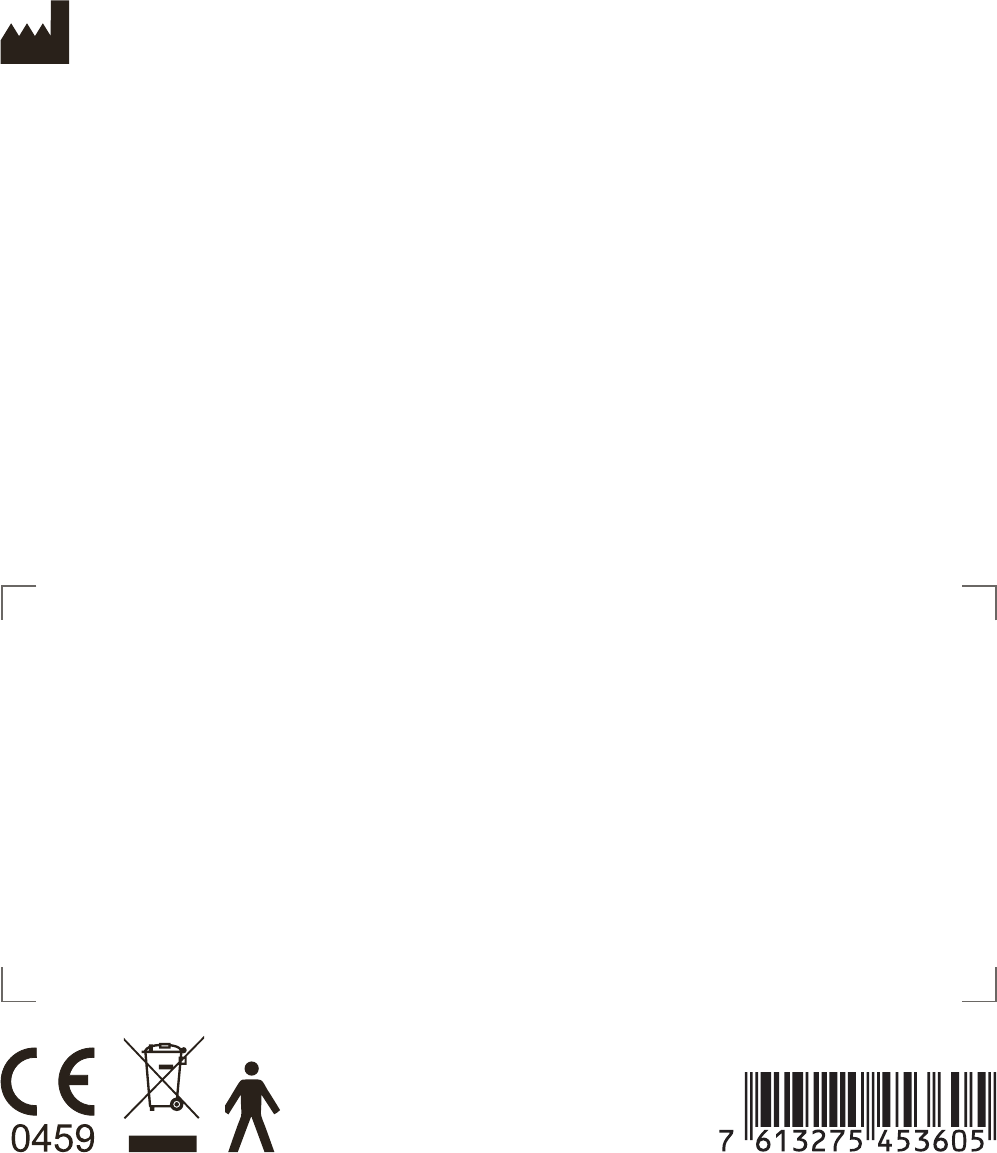
Manufacturer:
Phonak AG
Laubisrütistrasse 28
CH-8712 Stäfa
Switzerland
www.phonak.com
029-0365-02/V1.00/2015-06/cu Printed in Switzerland © Phonak AG All rights reserved
Your hearing care professional: